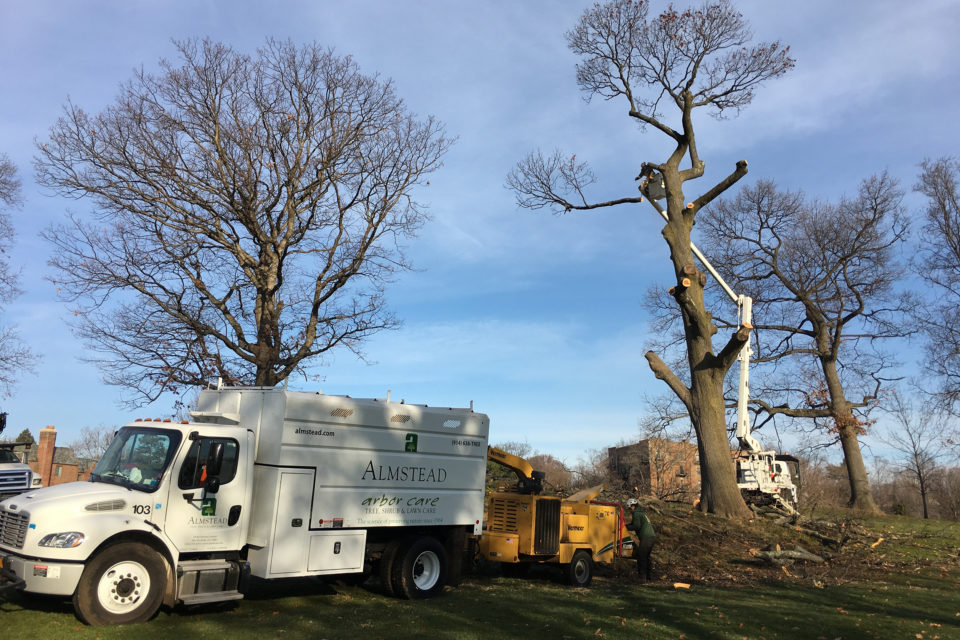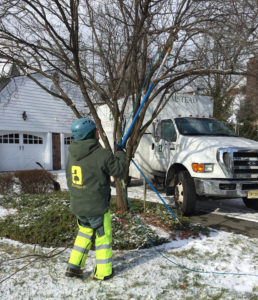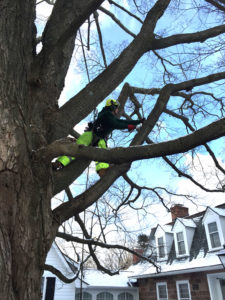Winter is the Best Time to Prune Your Trees

Winter tree care from Ken Almstead
 Winter is the Best Time to Prune Your Trees: If you want to ensure a beautiful spring for your trees, avoid dangerous falling branches, and save a little money, this winter, you should consider pruning your deciduous trees, treating your evergreens with antidesiccant, and removing unsafe trees, according to Ken Almstead, ISA Certified Arborist and CEO of Almstead Tree, Shrub & Lawn Care Co.
Winter is the Best Time to Prune Your Trees: If you want to ensure a beautiful spring for your trees, avoid dangerous falling branches, and save a little money, this winter, you should consider pruning your deciduous trees, treating your evergreens with antidesiccant, and removing unsafe trees, according to Ken Almstead, ISA Certified Arborist and CEO of Almstead Tree, Shrub & Lawn Care Co.
There are several reasons why deciduous trees should be pruned in winter. The most important of these is that an arborist can see the structure of a tree very clearly when there are no leaves on it. Think of it like a doctor working with an x-ray. It allows an arborist to identify weak, cracked and crossing branches, as well as structural flaws that could lead to branch or tree failures.
Prune Deciduous Trees Before Winter Storms
Winter storms can be dangerous pruners. It is far better to remove dead or cracked branches before winter does its own pruning, which can be dangerous for property, people, and even the tree.
 Another advantage to pruning in winter is that the ground is frozen and heavy equipment can be moved close to the tree without harming lawns or herbaceous perennials and annuals. And, since people tend to stay indoors during winter, there is less inconvenience to your family from crew and equipment working around the trees.
Another advantage to pruning in winter is that the ground is frozen and heavy equipment can be moved close to the tree without harming lawns or herbaceous perennials and annuals. And, since people tend to stay indoors during winter, there is less inconvenience to your family from crew and equipment working around the trees.
Finally, pruning in winter can save you a little money. It can take less time and effort to prune during winter because the branches are bare and the access with equipment may be moved closer to a tree in some instances. This cost savings in realized efficiencies is passed on to you. Tree care companies usually also have winter rates, when their work load is less, so you may be able to take advantage of that as well.
Winter Evergreen Care
When it comes to evergreens, it is better to prune them in the spring or summer. However, adding a coating of antidesiccant to their leaves in winter can ensure that they look good in the spring. When the weather is very cold and the ground freezes, evergreens are unable to absorb water from the surrounding soil easily. So, instead, they tend to use up the water stored in their leaves and stems, which results in brown or rust areas in the leaves. This is also known as “winter burn.” It becomes more unsightly and evident as temperatures rise in early spring. An antidesiccant application adds a waxy coating to the leaves, keeping the moisture inside.
 Many evergreens in our area are especially vulnerable to winter damage — particularly holly, rhododendron, cherry laurel, schip laurel, mountain laurel, Japanese skimmia, leucothoe, aucuba and boxwood. Ideally, it is recommended to use an antidesiccant on these plants in early winter, and another application in late-January to mid-February if the weather breaks.
Many evergreens in our area are especially vulnerable to winter damage — particularly holly, rhododendron, cherry laurel, schip laurel, mountain laurel, Japanese skimmia, leucothoe, aucuba and boxwood. Ideally, it is recommended to use an antidesiccant on these plants in early winter, and another application in late-January to mid-February if the weather breaks.
Winter is also a good time to remove unsafe trees. Snow, ice and storms can cause compromised trees to collapse. A certified arborist can inspect your landscape and advise you whether there are trees that may be at high risk of failure based upon performing a proper tree risk assessment. As with pruning, tree removal can be more efficient when the ground is frozen and we can move our equipment close to the tree without damaging the surrounding landscape.
By Ken Almstead… More on Winter Tree Care from Ken Almstead
Please feel free to contact Ken, or any of our certified and licensed Almstead arborists, if you have questions about your trees, shrubs, lawn, or tick management programs.
Ken Almstead is an ISA Certified Arborist, Tree Risk Assessment Specialist, and the CEO of Almstead Tree, Shrub & Lawn Care Co. He was named an ISA “True Professional of Arboriculture” in 2017.
(Almstead Tree, Shrub & Lawn Care Co, 15 Broadway, Hawthorne, New York 10532, 914.741.1510; www.almstead.com)
More from Ken Almstead in What To Do

















